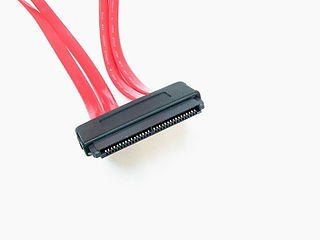IEEE 802.15 is a working group of the Institute of Electrical and Electronics Engineers (IEEE) IEEE 802 standards committee which specifies wireless personal area network (WPAN) standards. There are 10 major areas of development, not all of which are active.
The quantum Hall effect is a quantum-mechanical version of the Hall effect, observed in two-dimensional electron systems subjected to low temperatures and strong magnetic fields, in which the Hall conductance σ undergoes quantum Hall transitions to take on the quantized values

The Infrared Data Association (IrDA) is an industry-driven interest group that was founded in 1993 by around 50 companies. IrDA provides specifications for a complete set of protocols for wireless infrared communications, and the name "IrDA" also refers to that set of protocols. The main reason for using the IrDA protocols had been wireless data transfer over the "last one meter" using point-and-shoot principles. Thus, it has been implemented in portable devices such as mobile telephones, laptops, cameras, printers, and medical devices. Main characteristics of this kind of wireless optical communication is physically secure data transfer, line-of-sight (LOS) and very low bit error rate (BER) that makes it very efficient.
In the seven-layer OSI model of computer networking, the physical layer or layer 1 is the first and lowest layer. This layer may be implemented by a PHY chip.

High-temperature superconductors are materials that behave as superconductors at unusually high temperatures. The first high-Tc superconductor was discovered in 1986 by IBM researchers Georg Bednorz and K. Alex Müller, who were awarded the 1987 Nobel Prize in Physics "for their important break-through in the discovery of superconductivity in ceramic materials".

In IEEE 802 LAN/MAN standards, the medium access control (MAC) sublayer is the layer that controls the hardware responsible for interaction with the wired, optical or wireless transmission medium. The MAC sublayer and the logical link control (LLC) sublayer together make up the data link layer. Within the data link layer, the LLC provides flow control and multiplexing for the logical link, while the MAC provides flow control and multiplexing for the transmission medium.
IEEE 802.15.4 is a technical standard which defines the operation of low-rate wireless personal area networks (LR-WPANs). It specifies the physical layer and media access control for LR-WPANs, and is maintained by the IEEE 802.15 working group, which defined the standard in 2003. It is the basis for the Zigbee, ISA100.11a, WirelessHART, MiWi, 6LoWPAN, Thread and SNAP specifications, each of which further extends the standard by developing the upper layers which are not defined in IEEE 802.15.4. In particular, 6LoWPAN defines a binding for the IPv6 version of the Internet Protocol (IP) over WPANs, and is itself used by upper layers like Thread.

In computing, Serial Attached SCSI (SAS) is a point-to-point serial protocol that moves data to and from computer-storage devices such as hard drives and tape drives. SAS replaces the older Parallel SCSI bus technology that first appeared in the mid-1980s. SAS, like its predecessor, uses the standard SCSI command set. SAS offers optional compatibility with Serial ATA (SATA), versions 2 and later. This allows the connection of SATA drives to most SAS backplanes or controllers. The reverse, connecting SAS drives to SATA backplanes, is not possible.

A PHY, an abbreviation for "physical layer", is an electronic circuit, usually implemented as a chip, required to implement physical layer functions of the OSI model.
In physics, an oscillon is a soliton-like phenomenon that occurs in granular and other dissipative media. Oscillons in granular media result from vertically vibrating a plate with a layer of uniform particles placed freely on top. When the sinusoidal vibrations are of the correct amplitude and frequency and the layer of sufficient thickness, a localized wave, referred to as an oscillon, can be formed by locally disturbing the particles. This meta-stable state will remain for a long time in the absence of further perturbation. An oscillon changes form with each collision of the grain layer and the plate, switching between a peak that projects above the grain layer to a crater like depression with a small rim. This self-sustaining state was named by analogy with the soliton, which is a localized wave that maintains its integrity as it moves. Whereas solitons occur as travelling waves in a fluid or as electromagnetic waves in a waveguide oscillons may be stationary.
The System Packet Interface (SPI) family of Interoperability Agreements from the Optical Internetworking Forum specify chip-to-chip, channelized, packet interfaces commonly used in synchronous optical networking and Ethernet applications. A typical application of such a packet level interface is between a framer or a MAC and a network processor. Another application of this interface might be between a packet processor ASIC and a traffic manager device.
Physical Medium Dependent sublayers or PMDs further help to define the physical layer of computer network protocols. They define the details of transmission and reception of individual bits on a physical medium. These responsibilities encompass bit timing, signal encoding, interacting with the physical medium, and the properties of the cable, optical fiber, or wire itself. Common examples are specifications for Fast Ethernet, gigabit Ethernet and 10 Gigabit Ethernet defined by the Institute of Electrical and Electronics Engineers (IEEE).
CLEO was a general purpose particle detector at the Cornell Electron Storage Ring (CESR), and the name of the collaboration of physicists who operated the detector. The name CLEO is not an acronym; it is short for Cleopatra and was chosen to go with CESR. CESR was a particle accelerator designed to collide electrons and positrons at a center-of-mass energy of approximately 10 GeV. The energy of the accelerator was chosen before the first three bottom quark Upsilon resonances were discovered between 9.4 GeV and 10.4 GeV in 1977. The fourth Υ resonance, the Υ(4S), was slightly above the threshold for, and therefore ideal for the study of, B meson production.

The Ethernet physical layer is the physical layer functionality of the Ethernet family of computer network standards. The physical layer defines the electrical or optical properties of the physical connection between a device and the network or between network devices. It is complemented by the MAC layer and the logical link layer.
IEEE 802.11 – or more correctly IEEE 802.11-1997 or IEEE 802.11-1999 – refer to the original version of the IEEE 802.11 wireless networking standard released in 1997 and clarified in 1999. Most of the protocols described by this early version are rarely used today.
IEEE 802.11b-1999 or 802.11b, is an amendment to the IEEE 802.11 wireless networking specification that extends throughput up to 11 Mbit/s using the same 2.4GHz band. A related amendment was incorporated into the IEEE 802.11-2007 standard.

UniPro is a high-speed interface technology for interconnecting integrated circuits in mobile and mobile-influenced electronics. The various versions of the UniPro protocol are created within the MIPI Alliance, an organization that defines specifications targeting mobile and mobile-influenced applications.
Iron(II) selenide refers to a number of inorganic compounds of ferrous iron and selenide (Se2−). The phase diagram of the system Fe–Se reveals the existence of several non-stoichiometric phases between ~49 at. % Se and ~53 at. % Fe, and temperatures up to ~450 °C. The low temperature stable phases are the tetragonal PbO-structure (P4/nmm) β-Fe1−xSe and α-Fe7Se8. The high temperature phase is the hexagonal, NiAs structure (P63/mmc) δ-Fe1−xSe. Iron (II) selenide occurs naturally as the NiAs-structure mineral achavalite.
The Camera Serial Interface (CSI) is a specification of the Mobile Industry Processor Interface (MIPI) Alliance. It defines an interface between a camera and a host processor. The latest active interface specification is CSI-3 which was released in 2012.
The SCTE Hybrid Management Sub-Layer (HMS) refers to a set of specifications intended to support the design and implementation of inter-operable management systems for evolving HFC cable networks.








